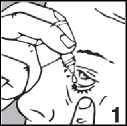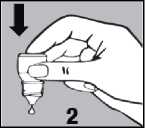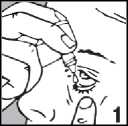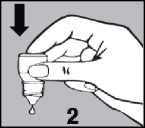Ciloxan Eye Drops
Out of date information, search anotherS0593 LEAFLET Ciloxan 20140415 Using other medicines
S0593 LEAFLET Ciloxan 20140415 Using other medicines

1)

PACKAGE LEAFLET: INFORMATION FOR THE USER CILOXAN EYE DROPS (ciprofloxacin hydrochloride)
Your medicine is known as Ciloxan Eye Drops but will be referred to as Ciloxan throughout the following leaflet.
Read all of this leaflet carefully before you start using this medicine.
• Keep this leaflet. You may need to read it again.
• If you have any further questions, ask your doctor or your pharmacist.
• This medicine has been prescribed for you. Do not pass it on to others. It may harm them, even if their symptoms are the same as yours.
• If any of the side effects get serious, or if you notice any side effects not listed in this leaflet, please tell your doctor or pharmacist.
IN THIS LEAFLET:
1. What Ciloxan is and what it is used for
2. Before you use Ciloxan
3. How to use Ciloxan
4. Possible side effects
5. How to store Ciloxan
6. Further information
1. WHAT CILOXAN IS AND WHAT IT IS USED FOR
Ciloxan belongs to a group of medicines known as quinolone antibiotics.
It is used for the treatment of corneal ulcers and some other bacterial infections of the eye(s).
2. BEFORE YOU USE CILOXAN
Do not use Ciloxan...
• If you are allergic (hypersensitive) to ciprofloxacin or any
other quinolone antibiotic or to any of the other ingredients listed in section 6.
Ask your doctor for advice.
Take special care...
• Only use Ciloxan in your eyes.
• Only use Ciloxan in children younger than 1 year if prescribed by your doctor.
• As with any antibiotic, use of Ciloxan for a long time may lead to other infections. If your symptoms get worse or suddenly return tell your doctor. You may become more susceptible to other infections with the use of this medicine, especially after prolonged use.
• If you notice the first signs of a skin rash or any other allergic reaction, including hives, itching, breathing problems stop treatment and immediately contact your doctor. If you have a serious allergic reaction then you may need emergency treatment.
• If you feel pain, swelling or inflammation while or shortly after taking this medicine, stop treatment and contact your doctor.
• If you are elderly or if you are taking medicines called 'corticosteroids' used to treat conditions such as pain and inflammation, asthma or skin problems then you have a higher risk of getting tendon problems during treatment with Ciloxan. If you experience any inflammation or inflammatory condition, stop treatment and immediately consult your doctor.
Pregnancy and breast-feeding
If you are pregnant or might get pregnant, or if you are breastfeeding a baby, talk to your doctor before you use Ciloxan.
Driving and using machines
If your sight is temporarily blurred or affected in any way following
use of Ciloxan you should not drive or operate machinery until
your vision is clear again.
Tell your doctor or pharmacist if you are taking or have recently taken any other medicines, including medicines obtained without a prescription.
If you are using more than one type of eye medicine, the medicines must be used at least 5 minutes apart. Eye ointments should be used last.
Important information if you wear Contact Lenses
There is a preservative in Ciloxan (benzalkonium chloride) that may cause eye irritation and can discolour soft contact lenses.
Do not wear contact lenses (hard or soft) during treatment with Ciloxan.
3. HOW TO USE CILOXAN
The usual dose
This will depend on whether you are being treated for corneal ulcers or for some other bacterial infection in your eye.
Corneal Ulcers
Dosing is continued during the night time.
Day 1 - 2 drops every 15 minutes for the first 6 hours and then 2 drops every 30 minutes.
Day 2 - 2 drops every hour.
Day 3 to Day 14 - 2 drops every 4 hours.
Your doctor will tell you if treatment needs to be continued for longer than 14 days.
Other bacterial infections
1 or 2 drops 4 times a day. For severe infections the dose for the first 2 days may be increased to 1 or 2 drops every 2 hours, while you are awake.
It is important that you continue to use Ciloxan for the full treatment period as advised by your doctor even if your symptoms improve. If you stop using this medicine too early, your symptoms may re-occur.
You should not use Ciloxan for more than 21 days, unless your doctor says otherwise.
Remove the loose collar from the cap when the bottle is first opened.
Always use Ciloxan exactly as your doctor has told you. You should check with your doctor or pharmacist if you are not sure.
How to use
• Wash your hands before you start.
• Twist off the bottle cap.
• Hold the bottle pointing down, between your thumb and fingers.
• Tilt your head back.
• Pull down your lower eyelid with a finger, until there is a 'pocket' between the eyelid and your eye. The drop will go in here (picture
• Bring the bottle tip close to the eye. Do this in front of a mirror if it helps.
• Do not touch your eye or eyelid,
surrounding areas or other surfaces with the dropper. It could infect the drops.
• Gently press on the base of the bottle to release one drop at a time (picture 2).
• Do not squeeze the bottle, only a gentle press on the bottom is needed.
• If you use drops in both eyes, repeat the steps for your other eye. Put the bottle cap firmly back on immediately after use.
• If a drop misses your eye, try again.
• If you forget to use Ciloxan, do not worry, just use it when it is next due. Do not take a double dose to make up.
• If you use more Ciloxan than you should it can be washed out of your eye with lukewarm water.
• If this medicine is accidentally swallowed, it is not likely to
cause any serious problems, but contact your doctor.
If you have any further questions on the use of Ciloxan, ask your doctor or pharmacist.
Like all medicines, Ciloxan can cause side effects, although not everybody gets them.
* You may experience some or all of the following effects in your eye(s) :
Common (1 to 10 users in 100): White deposits on the eye surface (cornea), discomfort (stinging or burning, gritty feeling in the eye, irritation), redness.
Uncommon (1 to 10 users in 1,000): Damage to or staining of the eye surface (cornea), sensitivity to light, blurred vision, swelling of the eye or eyelid, pain, dry eye, itchiness, abnormal sensation, eye discharge, eyelid crusting, eyelids scales, eyelid redness, poor vision, watery eyes, red eyes
Rare (1 to 10 users in 10,000): Damage of the eye, inflammation, disorder of the eye surface (cornea), double vision, decreased eye sensation, tired eyes
If you notice white particles in your eyes, continue to use Ciloxan but tell your doctor immediately.
* You may also experience effects in other areas of your body including:
Common: Bad taste.
Uncommon: Headache, nausea.
Rare: Hypersensitivity, dizziness, ear pain, stye, inflammation inside the nose, nasal sinus discharge, diarrhoea, abdominal pain, skin inflammation, drug intolerance, abnormal laboratory tests.
If any of the side effects get serious, or you notice any side effects not listed in this leaflet, tell your doctor or pharmacist.
If you experience an allergic reaction, stop using Ciloxan and tell your doctor.
Reporting of side effects
If you get any side effects, talk to your doctor, pharmacist or nurse. This includes any possible side effects not listed in this leaflet. You can also report side effects directly via the Yellow Card Scheme at: www.mhra.gov.uk/yellowcard.
By reporting side effects, you can help provide more information on the safety of this medicine.
What Ciloxan contains
* It contains 0.3%w/v of the active ingredient, ciprofloxacin (as the hydrochloride). It also contains 0.006%w/v of benzalkonium chloride as a preservative.
* Ciloxan Eye Drops also contain the following inactive ingredients: disodium edetate, mannitol, acetic acid, sodium acetate and purified water. Hydrochloric acid and/or sodium hydroxide may also be included in very small quantities to adjust the acidity or alkalinity of the product to ensure comfort of the product in the eye.
What Ciloxan looks like and contents of the pack
It is a sterile, colourless solution.
Ciloxan Eye Drops are available in bottle containing 5ml of solution.
Product Licence holder
Procured from within the EU and repackaged by the Product
Licence holder: S&M Medical Ltd, Chemilines House,
Alperton Lane, Wembley, Middlesex, HA0 1DX.
Manufacturer
This product is manufactured by Alcon-Couvreur NV, Puurs,
Belgium.
| POM | PL No: 19488/0593
Leaflet revision date: 15 April 2014
Ciloxan is a registered trademark of Alcon Inc., Switzerland.
S0593 LEAFLET Ciloxan 20140415
5. HOW TO STORE CILOXAN
* KEEP OUT OF THE SIGHT AND REACH OF CHILDREN.
* Do not store above 25°C. Store in the outer carton in order to protect from light.
* Do not refrigerate or freeze. Store upright.
* Discard 28 days after first opening.
* Do not use after the expiry date printed on the carton or bottle label.
* If your doctor tells you to stop using the medicine, please take it back to the pharmacist for safe disposal. Only keep the medicine if your doctor tells you to.
* If the medicine becomes discoloured or shows any other signs of deterioration, you should seek the advice of your pharmacist who will tell you what to do.


PACKAGE LEAFLET: INFORMATION FOR THE USER CIPROFLOXACIN 0.3% EYE DROPS (ciprofloxacin hydrochloride)
Your medicine is known as Ciprofloxacin 0.3% Eye Drops but will be referred to as Ciprofloxacin throughout the following leaflet.
Read all of this leaflet carefully before you start using this medicine.
• Keep this leaflet. You may need to read it again.
• If you have any further questions, ask your doctor or your pharmacist.
• This medicine has been prescribed for you. Do not pass it on to others. It may harm them, even if their symptoms are the same as yours.
• If any of the side effects get serious, or if you notice any side effects not listed in this leaflet, please tell your doctor or pharmacist.
IN THIS LEAFLET:
1. What Ciprofloxacin is and what it is used for
2. Before you use Ciprofloxacin
3. How to use Ciprofloxacin
4. Possible side effects
5. How to store Ciprofloxacin
6. Further information
1. WHAT CIPROFLOXACIN IS AND WHAT IT IS USED FOR
Ciprofloxacin belongs to a group of medicines known as quinolone antibiotics.
It is used for the treatment of corneal ulcers and some other bacterial infections of the eye(s).
2. BEFORE YOU USE CIPROFLOXACIN
Do not use Ciprofloxacin...
• If you are allergic (hypersensitive) to ciprofloxacin or any
other quinolone antibiotic or to any of the other ingredients listed in section 6.
Ask your doctor for advice.
Take special care...
• Only use Ciprofloxacin in your eyes.
• Only use Ciprofloxacin in children younger than 1 year if prescribed by your doctor.
• As with any antibiotic, use of Ciprofloxacin for a long time
may lead to other infections. If your symptoms get worse or suddenly return tell your doctor. You may become more susceptible to other infections with the use of this medicine, especially after prolonged use.
• If you notice the first signs of a skin rash or any other allergic reaction, including hives, itching, breathing problems stop treatment and immediately contact your doctor. If you have a serious allergic reaction then you may need emergency treatment.
• If you feel pain, swelling or inflammation while or shortly after taking this medicine, stop treatment and contact your doctor.
• If you are elderly or if you are taking medicines called 'corticosteroids' used to treat conditions such as pain and inflammation, asthma or skin problems then you have a higher risk of getting tendon problems during treatment with Ciprofloxacin. If you experience any inflammation or inflammatory condition, stop treatment and immediately consult your doctor.
Pregnancy and breast-feeding
If you are pregnant or might get pregnant, or if you are breastfeeding a baby, talk to your doctor before you use Ciprofloxacin.
Driving and using machines
If your sight is temporarily blurred or affected in any way following
use of Ciprofloxacin you should not drive or operate machinery
until your vision is clear again.
Tell your doctor or pharmacist if you are taking or have recently taken any other medicines, including medicines obtained without a prescription.
If you are using more than one type of eye medicine, the medicines must be used at least 5 minutes apart. Eye ointments should be used last.
Important information if you wear Contact Lenses
There is a preservative in Ciprofloxacin (benzalkonium chloride) that may cause eye irritation and can discolour soft contact lenses.
Do not wear contact lenses (hard or soft) during treatment with Ciprofloxacin.
3. HOW TO USE CIPROFLOXACIN
The usual dose
This will depend on whether you are being treated for corneal ulcers or for some other bacterial infection in your eye.
Corneal Ulcers
Dosing is continued during the night time.
Day 1 - 2 drops every 15 minutes for the first 6 hours and then 2 drops every 30 minutes.
Day 2 - 2 drops every hour.
Day 3 to Day 14 - 2 drops every 4 hours.
Your doctor will tell you if treatment needs to be continued for longer than 14 days.
Other bacterial infections
1 or 2 drops 4 times a day. For severe infections the dose for the first 2 days may be increased to 1 or 2 drops every 2 hours, while you are awake.
It is important that you continue to use Ciprofloxacin for the full
treatment period as advised by your doctor even if your symptoms improve. If you stop using this medicine too early, your symptoms may re-occur.
You should not use Ciprofloxacin for more than 21 days, unless your doctor says otherwise.
Remove the loose collar from the cap when the bottle is first opened.
Always use Ciprofloxacin exactly as your doctor has told you. You should check with your doctor or pharmacist if you are not sure.
How to use
• Wash your hands before you start.
• Twist off the bottle cap.
• Hold the bottle pointing down, between your thumb and fingers.
• Tilt your head back.
• Pull down your lower eyelid with a finger, until there is a 'pocket' between the eyelid and your eye. The drop will go in here (picture 1)
• Bring the bottle tip close to the eye. Do this in front of a mirror if it helps.
• Do not touch your eye or eyelid,
surrounding areas or other surfaces with the dropper. It could infect the drops.
• Gently press on the base of the bottle to release one drop at a time (picture 2).
• Do not squeeze the bottle, only a gentle press on the bottom is needed.
• If you use drops in both eyes, repeat the steps for your other eye. Put the bottle cap firmly back on immediately after use.
• If a drop misses your eye, try again.
• If you forget to use Ciprofloxacin, do not worry, just use it when it is next due. Do not take a double dose to make up.
• If you use more Ciprofloxacin than you should it can be
washed out of your eye with lukewarm water.
• If this medicine is accidentally swallowed, it is not likely to
cause any serious problems, but contact your doctor.
If you have any further questions on the use of Ciprofloxacin, ask your doctor or pharmacist.
What Ciprofloxacin contains
* It contains 0.3%w/v of the active ingredient, ciprofloxacin (as the hydrochloride). It also contains 0.006%w/v of benzalkonium chloride as a preservative.
* Ciprofloxacin Eye Drops also contain the following inactive ingredients: disodium edetate, mannitol, acetic acid, sodium acetate and purified water. Hydrochloric acid and/or sodium hydroxide may also be included in very small quantities to adjust the acidity or alkalinity of the product to ensure comfort of the product in the eye.
What Ciprofloxacin looks like and contents of the pack
It is a sterile, colourless solution.
Ciprofloxacin Eye Drops are available in bottle containing 5ml of
solution.
Product Licence holder
Procured from within the EU and repackaged by the Product
Licence holder: S&M Medical Ltd, Chemilines House,
Alperton Lane, Wembley, Middlesex, HA0 1DX.
Manufacturer
This product is manufactured by Alcon-Couvreur NV, Puurs,
Belgium.
I POM I PL No: 19488/0593
Like all medicines, Ciprofloxacin can cause side effects, although not everybody gets them.
* You may experience some or all of the following effects in your eye(s) :
Common (1 to 10 users in 100): White deposits on the eye surface (cornea), discomfort (stinging or burning, gritty feeling in the eye, irritation), redness.
Uncommon (1 to 10 users in 1,000): Damage to or staining of the eye surface (cornea), sensitivity to light, blurred vision, swelling of the eye or eyelid, pain, dry eye, itchiness, abnormal sensation, eye discharge, eyelid crusting, eyelids scales, eyelid redness, poor vision, watery eyes, red eyes
Rare (1 to 10 users in 10,000): Damage of the eye, inflammation, disorder of the eye surface (cornea), double vision, decreased eye sensation, tired eyes
If you notice white particles in your eyes, continue to use Ciprofloxacin but tell your doctor immediately.
* You may also experience effects in other areas of your body including:
Common: Bad taste.
Uncommon: Headache, nausea.
Rare: Hypersensitivity, dizziness, ear pain, stye, inflammation inside the nose, nasal sinus discharge, diarrhoea, abdominal pain, skin inflammation, drug intolerance, abnormal laboratory tests.
If any of the side effects get serious, or you notice any side effects not listed in this leaflet, tell your doctor or pharmacist.
If you experience an allergic reaction, stop using Ciprofloxacin and tell your doctor.
Reporting of side effects
If you get any side effects, talk to your doctor, pharmacist or nurse. This includes any possible side effects not listed in this leaflet. You can also report side effects directly via the Yellow Card Scheme at: www.mhra.gov.uk/yellowcard.
By reporting side effects, you can help provide more information on the safety of this medicine.
Leaflet revision date: 15 April 2014
S0593 LEAFLET Ciprofloxacin 20140415
5. HOW TO STORE CIPROFLOXACIN
* KEEP OUT OF THE SIGHT AND REACH OF CHILDREN.
* Do not store above 25°C. Store in the outer carton in order to protect from light.
* Do not refrigerate or freeze. Store upright.
* Discard 28 days after first opening..
* Do not use after the expiry date printed on the carton or bottle label.
* If your doctor tells you to stop using the medicine, please take it back to the pharmacist for safe disposal. Only keep the medicine if your doctor tells you to.
* If the medicine becomes discoloured or shows any other signs of deterioration, you should seek the advice of your pharmacist who will tell you what to do.